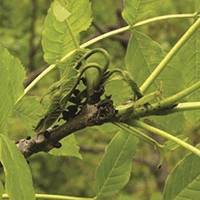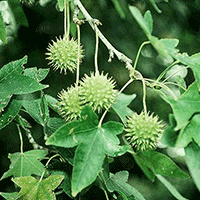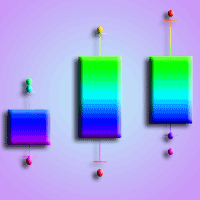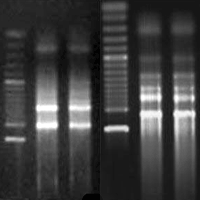
Genetic variation of Fraxinus excelsior half-sib families in response to ash dieback disease following simulated spring frost and summer drought treatments
Alfas Pliura (1-2) , Vaidotas Lygis (3), Diana Marčiulyniene (1), Vytautas Suchockas (1-2), Remigijus Bakys (1)
iForest - Biogeosciences and Forestry, Volume 9, Issue 1, Pages 12-22 (2015)
doi: https://doi.org/10.3832/ifor1514-008
Published: Sep 08, 2015 - Copyright © 2015 SISEF
Research Articles
Abstract
Ten juvenile Fraxinus excelsior half-sib families from two Lithuanian populations have been tested in the controlled environment for their response to ash dieback disease caused by Hymenoscyphus fraxineus, detecting changes of genetic variation and heritability, as well as estimating genotype by environment (G×E) interaction and phenotypic plasticity following artificial spring frost and summer drought treatments. In 2014, a batch of 200 four-year-old ash seedlings was used for each treatment and control (no treatment). Health condition, bud flushing phenology and height were assessed for each seedling, and disease incidence and survival ratios were assessed for each family both before (at the beginning of the vegetation season) and after the treatments (at the end of the vegetation season). Disease incidence ratio increased from 0.77-0.80 up to 0.90-0.95. Tree mortality rates during one vegetation season were significantly lower in the frost treatment (21%) than in the drought treatment (25%) or control (31%). None of the tested F. excelsior families were completely resistant to ash dieback, although significant among-family differences in disease incidence and damage rates suggest an additive mode of gene action and thus a quantitative resistance to the disease. Neither disease incidence rates, nor tree health condition scores differed significantly among the applied treatments (including control) indicating in general a negligible effect of the simulated adverse conditions on health status of the ash seedlings. However, G×E interaction was found to be significant (at P > 0.05) for disease incidence, length of necrotic shoots and tree survival, implying that susceptibility of ash families to the dieback disease unequally depends on environmental conditions, and indicating a presence of genetic variation in plasticity and reaction norms of the tested families across environments (treatments). Substantially increased coefficients of additive genetic variation and heritability in health condition following both frost and drought treatments and compared to control showed that simulated stress conditions may noticeably contribute to expression of differences among the tested F. excelsior families in their resistance traits, thus enabling a better evaluation of performance of different families, an effective family selection for resistance, and achievement of a marked genetic gain.
Keywords
Common Ash, Dieback, Disease Resistance, Genetic Variation, Heritability, Hymenoscyphus pseudoalbidus (Chalara fraxinea), Phenotypic Plasticity
Authors’ Info
Authors’ address
Diana Marčiulyniene
Vytautas Suchockas
Remigijus Bakys
Institute of Forestry, Lithuanian Research Centre for Agriculture and Forestry, Liepu str. 1, LT-53101 Girionys, Kaunas reg. (Lithuania)
Vytautas Suchockas
Aleksandras Stulginskis University, Studentu str. 13, LT-53361 Akademija - Kaunas (Lithuania)
Institute of Botany of Nature Research Centre, Zaliuju Ežeru str. 49, LT-08406 Vilnius (Lithuania)
Corresponding author
Paper Info
Citation
Pliura A, Lygis V, Marčiulyniene D, Suchockas V, Bakys R (2015). Genetic variation of Fraxinus excelsior half-sib families in response to ash dieback disease following simulated spring frost and summer drought treatments. iForest 9: 12-22. - doi: 10.3832/ifor1514-008
Academic Editor
Alberto Santini
Paper history
Received: Nov 26, 2014
Accepted: Jul 24, 2015
First online: Sep 08, 2015
Publication Date: Feb 21, 2016
Publication Time: 1.53 months
Copyright Information
© SISEF - The Italian Society of Silviculture and Forest Ecology 2015
Open Access
This article is distributed under the terms of the Creative Commons Attribution-Non Commercial 4.0 International (https://creativecommons.org/licenses/by-nc/4.0/), which permits unrestricted use, distribution, and reproduction in any medium, provided you give appropriate credit to the original author(s) and the source, provide a link to the Creative Commons license, and indicate if changes were made.
Web Metrics
Breakdown by View Type
Article Usage
Total Article Views: 47854
(from publication date up to now)
Breakdown by View Type
HTML Page Views: 40206
Abstract Page Views: 2749
PDF Downloads: 3790
Citation/Reference Downloads: 31
XML Downloads: 1078
Web Metrics
Days since publication: 3342
Overall contacts: 47854
Avg. contacts per week: 100.23
Citation Metrics
Article Citations
Article citations are based on data periodically collected from the Clarivate Web of Science web site
(last update: Feb 2023)
Total number of cites (since 2016): 18
Average cites per year: 2.25
Publication Metrics
by Dimensions ©
Articles citing this article
List of the papers citing this article based on CrossRef Cited-by.
References
Arbetsgång vid bearbetning av contortaförsök [Planning of work when analyzing trials of Lodgepole pine]. Arbetrapport 219, Institute for Forest Improvement, Uppsala, Sweden, pp. [in Swedish].
Gscholar
Common Ash (Fraxinus excelsior L.). In: “Forest Tree Breeding in Europe: Current State-of-the-Art and Perspectives” (Paques L ed). Series: Managing Forest Ecosystems vol. 25, Springer, Dordrecht, The Netherlands, pp. 403-462.
CrossRef | Gscholar
Introduction to quantitative genetics (3rd edn). Longman Group Ltd, London, UK, pp. 438.
Gscholar
Introduction to quantitative genetics (4th edn). Longman Group Ltd, London, UK, pp. 464.
Gscholar
Grybo Chalara fraxinea reikšme uosiu džiuties procese [Importance of fungus Chalara fraxinea in the process of ash dieback]. Musu Girios 11: 18-19. [in Lithuanian]
Gscholar
Adaptive strategies: polymorphism, plasticity, and homeostasis. In: “Topics in plant population biology” (Solbrig OT, Jain S, Johnson GB, Raven PH eds). Columbia University Press, New York, USA, pp. 160-187.
Gscholar
Lietuvos uosynu džiuvimo apimtys ir jas lemiantys veiksniai [The extent and possible causes of dieback of ash stands in Lithuania]. LZUU mokslo darbai, Biomedicinos mokslai 56: 17-22. [in Lithuanian with English summary]
Gscholar
The current situation of ash dieback caused by Chalara fraxinea in Austria. In: Proceedings of the Conference “IUFRO Working Party 7.02.02” (Dogmus-Lehtijärvi T ed). Egirdir (Turkey) 11-16 May 2009. SDU Faculty of Forestry Journal, Special Issue, pp. 97-119. -
Online | Gscholar
Klonforskelle i angreb af asketoptørre [Clonal variation in ash dieback]. Skoven 39: 522-525. [in Danish]
Gscholar
Studie av klonskillnader i känslighet för askskottsjuka [A study on clonal variation in susceptibility to ash dieback]. Arbetsrapport från Skogforsk 648, Uppsala, Sweden, pp. 14. [in Swedish]
Gscholar
Über eine Methode zur Erfassung der ökologischen Streubreite in Feldversuchen [About a method for detection of environmental variation range in field trials]. Z. Pflanzenzucht 47: 92-96. [in German]
Gscholar

















